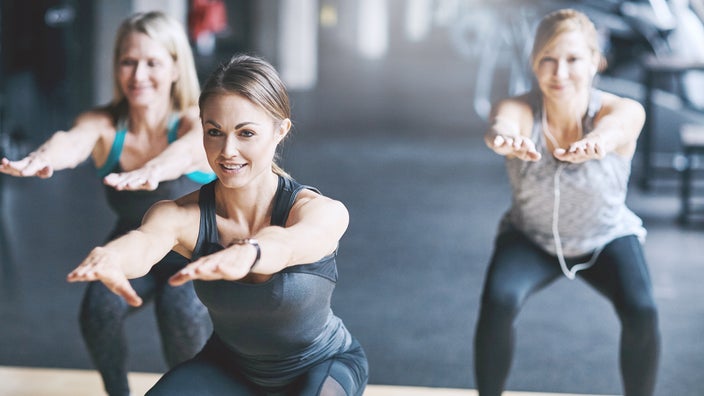
High-Intensity Interval Training (HIIT) Workouts for Beginners: Benefits, Exercises, and Tips to Get Started
Key takeaways:
High-intensity interval training (HIIT) involves alternating between short bursts of vigorous exercise and recovery periods.
HIIT workouts for beginners are an efficient way to burn calories, build endurance, and improve overall health.
HIIT workouts are adaptable for all fitness levels, including beginners. But talk with a healthcare professional first, especially if you have heart conditions or other health concerns.
Table of contents

High-intensity interval training (HIIT) combines vigorous exercise with recovery. It might sound daunting to exercise newbies. But the workouts can be adjusted for beginners, trained athletes, and everyone in between.
The training method is a great way to boost your endurance and burn calories. So, if you want to kick your workouts up a notch, HIIT might be just what you need. Learn its key benefits, exercises, and best practices to get started.
What is high-intensity interval training (HIIT)?
With HIIT, you alternate between short, vigorous exercise intervals and lower-intensity recovery intervals. For example, a HIIT treadmill workout might involve running for 1 minute and then walking briskly for 2 minutes. A beginner could do five rounds of these run-walk intervals to complete a 15-minute HIIT workout.
Save over 40% on Qsymia with GoodRx
Discover the once daily Qsymia for weight management. Qsymia is for adults and children 12-17 in combination with a healthy diet and regular exercise.

Because recovery is part of the workout, you can exert more effort. You can push your body harder during intense intervals than you do during continuous or steady-state exercise. During a moderate-intensity aerobic workout, the target heart rate is 50% to 70% of your maximum heart rate. The target heart rate during a HIIT interval is 80% to 95% of your maximum heart rate. That means you’re working as hard as you can.
During a HIIT workout, your muscles work so hard that your lungs can’t take in enough oxygen to sustain the movement for long. So you switch from aerobic to anaerobic exercise during brief high-intensity periods. HIIT aims to safely challenge your body and improve your heart health, endurance, and overall fitness.
What are the benefits of HIIT exercises?
HIIT is a heart-healthy exercise that offers several advantages. Here are key research-backed benefits of HIIT workouts.
1. Improves aerobic fitness
HIIT increases VO₂ max, a measure of your aerobic fitness and endurance. VO₂ max is the total amount of oxygen your body uses for energy during high-intensity exercise. And research indicates that HIIT may be more effective in improving VO₂ max than moderate, steady-state exercise.
2. Lowers blood pressure
The interval training method may improve multiple markers of heart health, including blood pressure. In one study, a 6-week HIIT program helped older men lower their blood pressure. They also had better cardiovascular function.
3. Reduces blood sugar levels
Studies suggest that HIIT lowers blood sugar levels. By increasing insulin sensitivity, both HIIT and moderate-intensity continuous training can help people with Type 2 diabetes manage their blood sugar. Exercise, including HIIT, can also reduce the risk of developing Type 2 diabetes.
Not sure how hard you're exercising during HIIT? Understanding your rate of perceived exertion can help.
Ready to take HIIT workouts to the next level? Try Tabata. This interval training workout can improve your cardio fitness and strengthen your muscles.
What should you do on rest days? Experts recommend active recovery. These lower-intensity workouts help restore your muscles and maximize your fitness gains.
4. Burns calories quickly
During high-intensity intervals, you exercise at near-maximum effort, raising your heart rate. While you don’t work as hard during brief recovery intervals, your heart rate is still higher than when you’re at rest. So your heart rate stays elevated throughout the workout, allowing you to burn calories quickly.
According to one review, HIIT may be just as effective as continuous, moderate-intensity exercise at improving cardiovascular disease risk factors. But you can do HIIT workouts in less time. That’s good news for people with busy schedules who only have time for short workouts.
5. Increases metabolism
You may keep burning calories after your HIIT workout ends. Research shows that HIIT increases excess postexercise oxygen consumption (EPOC). With EPOC, your body burns calories by restoring oxygen after a workout.
Read more like this
Explore these related articles, suggested for readers like you.
6. Supports healthy weight loss
Greater calorie burn may support healthy weight loss. One review found that HIIT helped people lose more body fat than moderate, steady-state exercise.
7. Builds muscle
Losing weight doesn’t mean you have to lose muscle, too. HIIT workouts can include several exercises, allowing you to target multiple muscle groups. Doing so can help you build or maintain muscle mass.
Researchers examined the effects of HIIT workouts for beginners. After 3 weeks, inactive, middle-aged men had increased lean muscle mass and strength. HIIT workouts may also increase muscle power, which can boost your athletic performance.
8. Promotes better sleep
It might not be surprising that challenging HIIT workouts can help you sleep better. A small study found that high- and moderate-intensity interval training reduced fatigue and improved sleep quality.
9. Boosts memory
It’s no secret that regular exercise is good for your brain. HIIT has been shown to improve cognitive function. In a small study, researchers looked at how exercise affected memory in older adults. HIIT improved memory better than steady-state exercise and stretching.
10. Enhances mental health
HIIT has been linked to better mental health. The training method may reduce stress and symptoms of depression in people with physical and mental illnesses.
What are the disadvantages of HIIT workouts?
There are some disadvantages of HIIT workouts, including the following:
Injury risk: HIIT workouts require a lot of effort in a short amount of time. Moving too quickly or vigorously, especially with improper form, may increase the risk of overtraining or injuries such as sprains and strains.
Longer recovery time: A HIIT session can shorten your workout time. But you might need more time to recover from the demanding training method. Remember to cool down after HIIT workouts. And take at least 1 to 2 recovery days between sessions.
Not suitable for everyone: You can modify HIIT workouts based on your fitness level. But the vigorous workout style isn’t suitable for everyone. People with coronary disease or other heart conditions, joint problems, and other health concerns may need to avoid HIIT. That’s why it’s critical to talk with a healthcare professional before starting interval training.
How do you get started with HIIT?
After you get the OK from a healthcare professional, you can plan your HIIT workout.
Focus on interval duration, intensity, and frequency. The challenging intervals should be short enough that you can safely work at maximum effort. HIIT workouts for beginners might include a 2:1 or 3:1 recovery-to-work ratio. That means your recovery intervals are two to three times as long as your high-intensity intervals. For example, a 3:1 ratio might include 30-second high-intensity intervals followed by 90-second recovery intervals.
Exercise intensity can be relative. So it might be difficult to gauge at first. It depends on your current health, fitness level, and how challenging an exercise feels to you. Consider starting with moderate-intensity intervals instead of high-intensity if you’re a beginner. You can use a fitness tracker to monitor your heart rate. Or you can use the talk test to get a better idea of your exercise intensity.
HIIT workouts vary in length. You can start with shorter, 10-minute sessions. Then, slowly work up to a 15- or 20-minute routine. Remember to make time for a warm-up and cooldown sequence with every workout.
What are the best HIIT workouts for beginners?
You have a lot of options when it comes to HIIT workouts for beginners. It’s best to start with beginner-friendly activities like brisk walking or jogging. If you work out regularly, you can try exercises –– like running, cycling, or doing squats –– that are already part of your routine.
Ideally, your HIIT routine will include moves that target multiple muscle groups, providing a total-body workout. There are plenty of equipment-free options, so you can try your HIIT workout at home or the gym.
Though far from a complete list, here are some HIIT workouts for beginners:
Stair climbing
Running
Cycling
Jumping jacks
Body-weight squats
Sample HIIT workout for beginners
You can apply HIIT to almost any type of exercise, including aerobics and body-weight strength training.
Here’s an example cardio HIIT workout for beginners:
Warm-up: Repeat each exercise for 1 minute to complete a 5-minute warm-up: shoulder rolls, arm swings, hip circles, jogging in place, and side lunges.
Jumping jacks: Do as many jumping jacks as you can for 30 seconds. Rest or recover with step jacks for 60 seconds.
High knees: Run in place as fast as you can with high knees for 30 seconds. Rest or recover by marching in place for 60 seconds.
Mountain climbers: Start in a plank position to do quick mountain climbers –– think of it as running in place on the floor –– for 30 seconds. Rest or slow your pace to recover for 60 seconds.
Skater jumps: Hop from side to side to do skater jumps for 30 seconds. Rest or recover by stepping from side to side –– without the jump –– for 60 seconds.
Burpees: Do as many burpees as you can for 60 seconds. Rest or recover by walking in place for 60 seconds.
Cooldown: March in place or walk for 2 minutes to ease into a cooldown. Follow up with targeted stretches. Examples include the crossbody shoulder stretch, standing quadriceps stretch, or hamstring stretch.
As you build endurance, you can repeat the circuit –– with 5 exercise and 5 recovery intervals –– twice.
How often should you do HIIT workouts?
HIIT requires a lot of energy and effort. And too much high-intensity exercise may be bad for your health. So it’s essential to give your body adequate rest between workouts. Consider adding HIIT to your routine once or twice a week to avoid injury or overtraining. Take at least 1-2 active recovery days between HIIT sessions.
Frequently asked questions
It depends on factors such as your current weight, exercise intensity, and consistency. A complete plan for healthy weight loss should include regular exercise, a balanced diet, adequate sleep, and other lifestyle strategies.
Experts recommend gradual weight loss, up to 1 lb to 2 lbs per week, and that may be an ambitious goal for some people. If your HIIT workouts are part of a complete weight-loss plan, you may lose 10 lbs in 5 to 10 weeks or so. Try to focus on creating sustainable habits instead of stressing about the number on the scale.
You can’t target fat loss to specific body parts. But HIIT and running can help you lose body fat, including in your stomach. That said, HIIT may be better for burning fat than running and other steady-state exercises. It helps you burn calories quickly. You may even keep burning calories after HIIT workouts thanks to the afterburn effect.
The bottom line
High-intensity interval training combines vigorous exercise intervals with recovery periods. It can be a great way to burn calories, build muscle, and boost your fitness, especially if you’re short on time. And it’s versatile. So you can try it even if you’re a beginner. The key is to adjust your exercise intensity based on your fitness level to avoid overdoing it.
Why trust our experts?



References
American Council on Exercise. (n.d.). Mountain climbers.
Boutcher, S. H. (2010). High-intensity intermittent exercise and fat loss. Journal of Obesity.
Callahan, M. J., et al. (2021). Skeletal muscle adaptive responses to different types of short-term exercise training and detraining in middle-age men. Medicine and Sciences in Sports and Exercise.
Centers for Disease Control and Prevention. (2022). Measuring physical activity intensity.
Centers for Disease Control and Prevention. (2023). Steps for losing weight.
Ciolac, E. G. (2012). High-intensity interval training and hypertension: Maximizing the benefits of exercise? American Journal of Cardiovascular Disease.
Darebee. (2015). Exercise library: Step jacks [video]. YouTube.
Di Liegro, C. M., et al. (2019). Physical activity and brain health. Genes.
FitnessBlender. (2010). High knees (lv 2) [video]. YouTube.
FitnessBlender. (2010). Lateral jumps (lv 1) [video]. YouTube.
Flockhart, M., et al. (2021). Excessive exercise training causes mitochondrial functional impairment and decreases glucose tolerance in healthy volunteers. Cell Metabolism.
Grace, F., et al. (2018). High intensity interval training (HIIT) improves resting blood pressure, metabolic (MET) capacity and heart rate reserve without compromising cardiac function in sedentary aging men. Experimental Gerontology.
Herbert, P., et al. (2017). HIIT produces increases in muscle power and free testosterone in male masters athletes. Endocrine Connections.
Jelleyman, C., et al. (2015). The effects of high-intensity interval training on glucose regulation and insulin resistance: A meta-analysis. Obesity Reviews.
Jiménez-García, J. D., et al. (2021). Effects of HIIT and MIIT suspension training programs on sleep quality and fatigue in older adults: Randomized controlled clinical trial. International Journal of Environmental Research and Public Health.
Kravitz, L. (n.d.). High-intensity interval training. American College of Sports Medicine.
Kovacevic, A., et al. (2020). The effects of aerobic exercise intensity on memory in older adults. Applied Physiology, Nutrition, and Metabolism.
LiQiang, S., et al. (2019). Effects of HIIT and MICT on cardiovascular risk factors in adults with overweight and/or obesity: A meta-analysis. PLoS One.
Martland, R., et al. (2020). Can high intensity interval training improve health outcomes among people with mental illness? A systematic review and preliminary meta-analysis of intervention studies across a range of mental illnesses. Journal of Affective Disorders.
Martland, R., et al. (2022). Can high-intensity interval training improve mental health outcomes in the general population and those with physical illnesses? A systematic review and meta-analysis. British Journal of Sports Medicine.
Mekari, S., et al. (2020). High-intensity interval training improves cognitive flexibility in older adults. Brain Sciences.
Min, L., et al. (2021). Effects of high-intensity interval training on sleep: A systematic review and meta-analysis. International Journal of Environmental Research and Public Health.
Panissa, V. L. G., et al. (2021). Magnitude and duration of excess of post-exercise oxygen consumption between high-intensity interval and moderate-intensity continuous exercise: A systematic review. Obesity Reviews.
Poon, E. T., et al. (2021). Interval training versus moderate-intensity continuous training for cardiorespiratory fitness improvements in middle-aged and older adults: A systematic review and meta-analysis. Journal of Sports Science.
Ryan, B. J., et al. (2020). Moderate-intensity exercise and high-intensity interval training affect insulin sensitivity similarly in obese adults. The Journal of Clinical Endocrinology and Metabolism.
Viana, R. B., et al. (2019). Is interval training the magic bullet for fat loss? A systematic review and meta-analysis comparing moderate-intensity continuous training with high-intensity interval training (HIIT). British Journal of Sports Medicine.
Weston, K. S., et al. (2014). High-intensity interval training in patients with lifestyle-induced cardiometabolic disease: A systematic review and meta-analysis. British Journal of Sports Medicine.





























